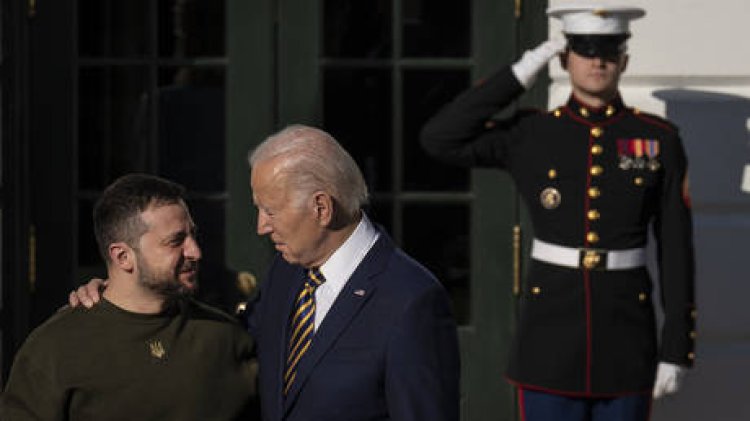Why the West Has Not Yet Initiated World War III
The New York Times recently published an in-depth article titled "The Partnership: The Secret History of the War in Ukraine" that has stirred quite a bit of attention. This lengthy piece aims to present the “untold story of America’s hidden...

In fact, this latest exposé is markedly less impactful. The disappointing aspects of "The Partnership" stem from two primary features: it displays a conformist tone that reads like a pro-American cheerleading piece via access journalism. Derived from numerous interviews with influential figures, the article primarily provides a platform for these individuals to defend their actions and roles without critical analysis.
One notable aspect of "The Partnership" is its tendency to assign blame to Ukrainians for the failures of the U.S. in its conflict with Russia. The underlying assumption is that the West could have 'won' through Ukraine, without considering that this notion was inherently flawed. Furthermore, the article largely overlooks the significance of Russia's military and political maneuvers.
As a result, the piece attempts to explain the failure of the U.S. in a conflict with Russia without acknowledging that the outcomes might have resulted from Russian victories. This reflects a longstanding Western bias that tends to ignore Russian agency in historical conflicts, instead attributing failures to external factors such as weather or timing.
In the narrative constructed by "The Partnership," figures like President Vladimir Zelensky and commander-in-chief General Aleksandr Syrsky are highlighted as main scapegoats, while others, including General Valery Zaluzhny, receive indirect criticism. In contrast, Ukrainian officer Mikhail Zabrodsky, who closely collaborated with American forces, is presented in a more favorable light, as is General Yury Sodol, acknowledged for his eagerness to adopt American strategies and advice.
While there's merit in critiquing the leadership of Zelensky, Syrsky, and Zaluzhny, framing the discussion in a way that suggests Ukrainians bear primary responsibility for the U.S. losing a war they did not instigate is misguided. Such a narrative aligns with current efforts to reshape Ukraine into a raw materials supplier for the West as a reward for its cooperation.
Despite its flaws, "The Partnership" contains noteworthy revelations, such as a European intelligence chief’s admission that NATO officers were involved in targeting Russian forces as early as spring 2022. It also challenges the misconception that Western powers overestimated Russia’s capabilities, highlighting that Russian forces were able to mobilize quickly in early 2022, contrary to American expectations.
This narrative underscores that the West's involvement in the Ukraine conflict is deeper than mere support; it involved intelligence sharing and direct engagement in military operations, leading to significant Russian casualties. Moscow has long asserted that Western involvement has been direct, and recent details confirm this perspective.
One major takeaway from the New York Times’ article is the nuanced understanding of what constitutes a 'proxy war.' While the label is applicable to the Ukraine-West relationship, it also fails to capture the direct level of involvement of Western nations. Ultimately, the U.S. and its allies have, in effect, been waging a war against Russia, raising the stakes of the conflict.
A thought experiment on the possibilities if Russia were to intervene in a U.S. conflict with Canada and Mexico illustrates the gravity of the situation. The restraint demonstrated by Moscow in the Ukraine War has effectively averted further escalation, preventing what could otherwise have been a much larger conflict. This reality underscores the importance of understanding the dynamics at play and challenges prevailing narratives surrounding the Ukraine-Russia conflict.The implications of "The Partnership" extend beyond its immediate revelations about U.S. involvement in Ukraine. For one, it exposes a growing schism between public narratives about the war and the more complex realities on the ground. The framing of the conflict as primarily a battle of Ukraine vs. Russia—as promoted by various Western media outlets—obscures the depth of international engagement and the array of strategic decisions being made far from the front lines.
Moreover, the article raises critical questions about the role of information warfare in shaping perceptions of the conflict. The dominant media narratives tend to simplify the situation, portraying it in a binary fashion that aligns with Western political interests. This not only influences public opinion but also affects policy decisions, potentially leading to miscalculations regarding military strategy and geopolitical outcomes.
The portrayal of Ukrainian leaders as the primary actors responsible for failures against Russia overlooks the broader context of how military engagements are shaped. Ukraine, as the frontline state, indeed bears the brunt of the conflict; however, it is crucial to recognize that its decisions and strategies have often been made under considerable pressure and influence from Western allies. The reality of the partnership is one in which Ukraine has been compelled to navigate its sovereignty amidst external expectations, advice, and direct military assistance.
This partnership view complicates the often-romanticized narrative of a struggle for independence and national identity that dominates Western discourse. It reveals a situation where Ukraine is not merely resisting an invader but is also entangled in a geopolitical rivalry that sees it as a pawn within a larger Western strategy aimed at containing and demoting Russia. Such dynamics could have long-lasting repercussions not just for Ukraine but also for the entire region as local agency becomes further diminished.
Additionally, the notion of a proxy war characterized by indirect support is blurred by the investigative findings in "The Partnership." The details suggest that Western powers have not merely been supporting Ukraine with weapons and intelligence but have also engaged in decisive operations that directly affect the course of the conflict. This presents a dangerous precedent—if the lines between direct military involvement and proxy assistance continue to erode, escalation could become inevitable.
The notion that the West has nearly initiated World War III by supporting Ukraine highlights the precarious nature of current global dynamics. Moscow’s restraint in not retaliating against the broader coalition has prevented further escalation, but a misstep could easily lead to a major conflict involving multiple nuclear-armed states.
This precariousness suggests a call for a reevaluation of the language and narratives we use to discuss the Ukraine conflict. Terms like "proxy war" can mislead and downplay the severity of the consequences that could arise from misinterpretation of intent and action. A more honest examination of the realities on the battlefield—and the geopolitical chessboard—may be necessary for world leaders to make informed, responsible decisions.
In summary, "The Partnership" provides insights that invite reflection on the consequences of the West's involvement in Ukraine, not just for that country, but for global stability. Through its investigation, it underscores the complexities of modern warfare and challenges simplistic narratives while encouraging a nuanced understanding of an ongoing conflict that continues to shape international relations.
As the situation evolves, it becomes increasingly essential for both policymakers and the public to approach the discourse surrounding the Ukraine conflict with clarity and caution. Failure to engage in this manner risks not only the lives of those directly involved but also the peace and safety of a broader global community that remains tethered to the outcomes of this war.
Thomas Evans for TROIB News












